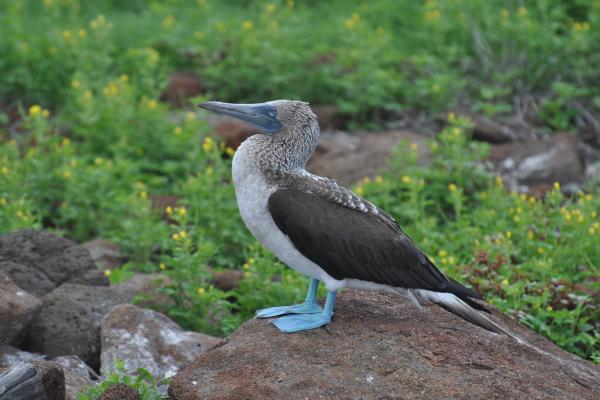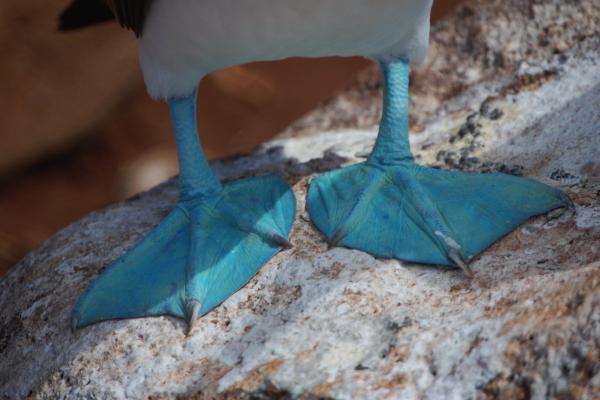The blue-footed booby (scientific name: Sula nebouxii), also known as the blue-footed gannet, is one of the most striking seabirds in the Pacific region, famous for its vivid blue feet. Not only are these birds remarkable for their appearance, but their courtship dances and feeding habits also make them a fascinating subject for wildlife enthusiasts and researchers alike. This article offers an in-depth look at the blue-footed booby’s characteristics, habitat, diet, and breeding behaviors—essential reading for anyone interested in marine birds or biodiversity.

The most distinctive trait of the blue-footed booby is its bright blue feet, which are a direct result of its carotenoid-rich diet. Adults typically measure about 80 cm (31 in) in length with a wingspan of up to 90 cm (35 in). Their long, pointed beaks and wings make them excellent divers and agile flyers. Females are slightly larger than males, demonstrating slight sexual dimorphism.
The bird’s plumage is mostly white, with brown wings and back covered in white spots. Adult boobies often show pale streaks on their heads. Their temperament is quite docile, and historically this lack of fear towards humans made them easy targets for early hunters and explorers.

Blue-footed boobies are found along the eastern Pacific coast, from the Gulf of California in Mexico, along Central America, the Galápagos Islands, and down to Peru. These are quintessential marine birds, spending the majority of their lives at sea and coming ashore only to breed in large colonies.
Some of the most important breeding grounds include Isla Isabel National Park in Nayarit, Mexico, and the Galápagos Islands in Ecuador, both of which host thousands of nesting pairs every season.
The diet of the blue-footed booby consists primarily of fish, with a strong preference for sardines and anchovies. They employ a spectacular hunting method: plunging from heights of up to 15 meters (50 feet) into the water to catch prey with their beaks. To handle the pressure of such dives, their nostrils have evolved to close, and they breathe through their mouths instead.
Their blue foot color results from their inability to synthesize carotenoids; instead, these pigments are stored in their feet from their diet. The brighter the blue, the healthier the bird—which also influences their success in attracting mates.

Blue-footed boobies are renowned for their elaborate courtship displays. Males perform a series of dances, showcasing their blue feet, spreading their wings, and vocalizing to attract females. If the female is interested, she responds by showing her own feet and touching beaks with the male, leading to successful pairing.
The breeding season usually runs from November to July. Nests are simple ground scrapes, often ringed with guano. Clutches contain one to three eggs, incubated for around 40 days by both parents. Siblings typically hatch several days apart, leading to a size hierarchy within the brood. In times of food scarcity, the larger chick may outcompete or even eliminate smaller siblings.
Blue-footed boobies are long-lived birds, with lifespans reaching up to 20 years. Most adults return to their birthplace to breed, displaying strong site fidelity.
While the blue-footed booby is not currently classified as endangered, its populations are sensitive to changes in marine ecosystems, pollution, and food availability. As an indicator species, shifts in their numbers or behavior can signal broader ecological changes in the marine environment.
The blue-footed booby is a captivating bird, not only for its unusual appearance and lively mating dances but also for its important role in marine ecosystems. For more information on blue-footed boobies, seabirds, and marine biodiversity, explore our website’s extensive wildlife resources.
Suggested SEO Keywords: blue-footed booby, Sula nebouxii, blue-footed booby facts, blue-footed booby distribution, blue-footed booby diet, blue-footed booby reproduction, Galápagos seabirds, Pacific marine birds
Bibliography
Kaufman, K. (2005). Field Guide to the Birds of North America. New York: Hillstar Editions.
UNAM Institute of Ecology (n.d.). Reproductive Ecology of the Blue-footed Booby on Isabel Island, Nayarit. Available at: http://web.ecologia.unam.mx/isla_isabel/proyecto.html
animal tags: Blue-footed booby
We created this article in conjunction with AI technology, then made sure it was fact-checked and edited by a Animals Top editor.